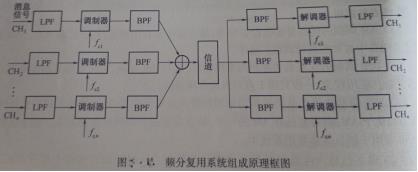Frequency Division Multiplexing
When the transmission capacity of a physical channel is higher than the demand of one signal, the channel can be shared by multiple signals. For example, the trunk line of a telephone system usually has thousands of signals transmitted on one optical fiber. Multiplexing is the technology that solves how to use a channel to transmit multiple signals at the same time. The purpose is to make full use of the frequency band or time resources of the channel and improve the utilization rate of the channel.
There are two common methods of signal multiplexing: frequency division multiplexing (FDM) and time division multiplexing (TDM) Time division multiplexing is usually used for the multiplexing of digital signals. Frequency division multiplexing is mainly used for the multiplexing of analogue signals but can also be used for digital signals. This section will discuss the principle and application of FDM.
Frequency division Multiplexing is a multiplexing method that divides channels according to frequency. In FDM, the bandwidth of a channel is divided into a plurality of frequency bands (sub-channels) that do not overlap each other. Each channel of signals occupies one of the sub-channels, and unused frequency bands (guard bands) must be reserved between the channels to prevent signal overlap. At the receiving end, an appropriate band-pass filter separates the multiple signals and recovers the required signals.
The following figure shows the principle block diagram of the frequency division multiplexing system. At the transmitting end, each baseband voice signal is first passed through a low-pass filter (LPF) to limit the highest frequency of each signal. Then, each channel of signals is modulated to different carrier frequencies, so that each channel of signals is moved to its frequency range, and then combined and sent to the channel for transmission. A series of band-pass filters with different centre frequencies at the receiving end is used to separate the modulated signals. After they are demodulated, the corresponding baseband signals of each channel are recovered.
In order to prevent mutual interference between adjacent signals, the carrier frequency F should be reasonably selected_ c1,f_ c2,···,f_ Cn so that a certain guard band is reserved between the modulated signal spectrums.
This is what Shenzhen HDV phoelelectron Technology Co., Ltd. has brought to you about the knowledge of frequency division multiplexing. I hope this article can help you to increase your knowledge. Besides this article if you’re looking for a good optical fiber communication equipment manufacturer company you may consider about us.
Shenzhen HDV photoelectric Technology Co., Ltd. is mainly a manufacturer of communication products. At present, the equipment produced covers the ONU series, optical module series, OLT series, and transceiver series. We can provide customized services for different scenarios. You are welcome to consult.
